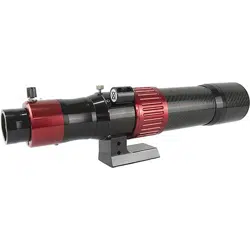Loading ...
Loading ...
Loading ...

How it works:
After the objective, light from the telescope enters the blocking filter (at
left), where wavelengths near H alpha are transmitted while the rest are
reflected back out. Red H alpha light then passes through the telecentric
barlow lens elements to achieve a slower focal ratio, more parallel light
beam. The Etalon passes a very narrow range of light wavelengths, but
it is sensitive to temperature and light angle. In the Quark, the Etalon is
heated to approximately 100-150°F to control the wavelength passed,
and the telecentric barlow controls the angle of light entering the Etalon.
Care and cleaning:
While not in use, we recommend that users store the optics with their
end caps on, in a climate controlled environment. The optical filter life
expectancy is extended up to 2-3 times by climate controlled storage.
Do not touch the optical elements. While the exterior glass surface
coatings are durable, they are easily scratched. A few specks of dust will
have no effect on the quality of the image, and may be gently blown off
with a squeeze bulb. Do NOT use compressed air cans to blow dust off
any optical surfaces. Small amounts of residual 'film' will not affect visual
performance. Fingerprints, smudges and smears must be cleaned off.
Preferred cleaning method is to return the telescope to the DayStar
Filters laboratory for proper factory cleaning.
Do not unscrew, open or separate your filter assembly. The optical
elements are held under pressure by design and will become damaged if
opened. Opening the optical filter assembly will void your warranty. The
safest cleaning method is to moisten a very soft, lint-free tissue, cloth or
"Qtip" with a pure acetone, methanol, or Isopropyl Alcohol (reagent
grade) and gently whisk away the stain. Do not apply solutions directly to
the glass surface. Stroke from the center of the aperture outward only.
After each cleaning stroke, use a fresh applicator. The fewer strokes, the
better! The metal housing and other non optical parts are anodized
surfaces and can be cleaned with Windex.
Loading ...
Loading ...
Loading ...
